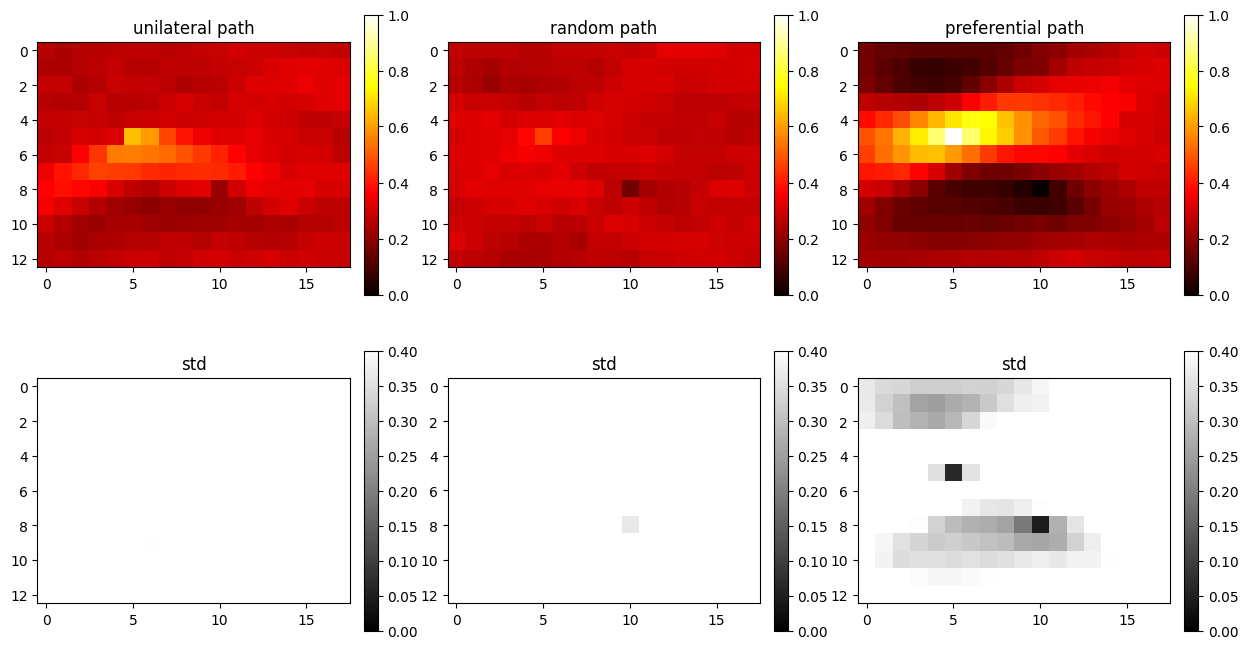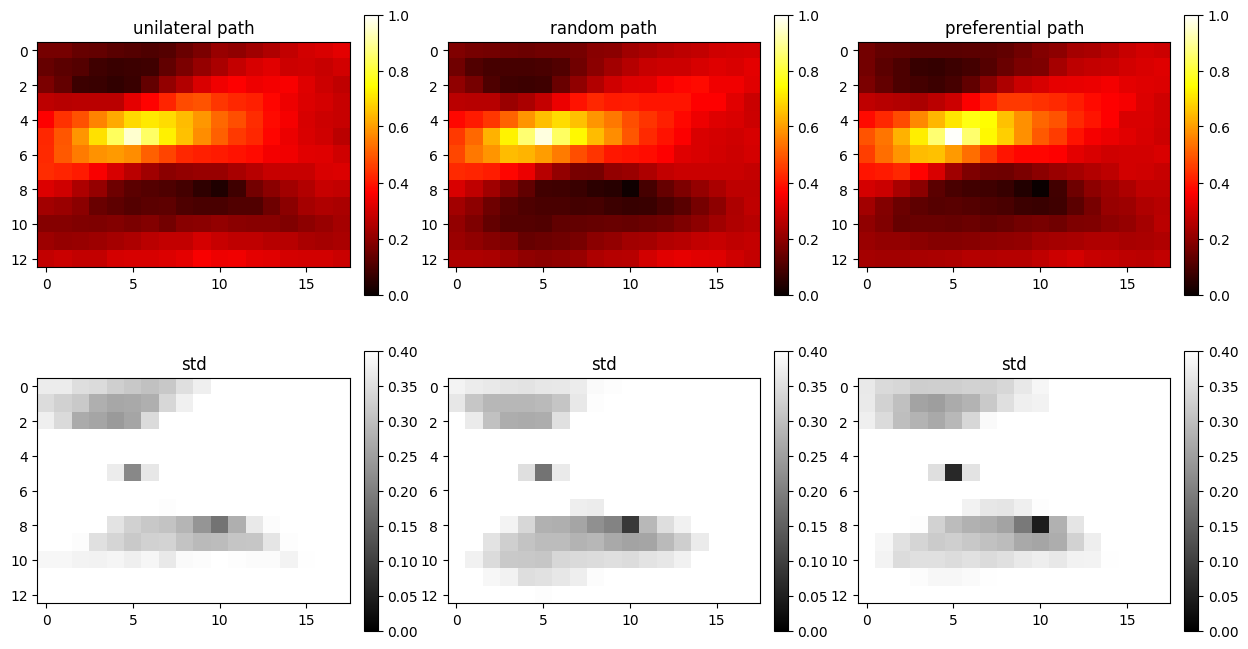MPSlib: hard and soft data in MPSlib
MPSlib can account for hard and soft data (both colocated and no-colocated). Detail about the use of the preferential path and co- and non-co-located soft data can be found in
mps_snesim_tree and mps_snesim_list can account for both colocated soft data only.
mps_genesimcan account for both colocated and non-colocated soft data.
Define hard data
Hard data (model parameyers with no uncertainty) are given by the ‘’’d_hard’’’ variable, with X, Y, Z, and VALUE for each conditonal data. 3 conditional hard data can be given by
O.d_hard = np.array( [[ ix1, iy1, iz1, val1],
[ ix2, iy2, iz2, val2],
[ ix3, iy3, iz3, val3]])
Define soft/uncertain data
Soft data (model parametrs wth no uncertainty) are given by the ‘’’d_soft variable, with X, Y, Z, for the position, and a probability of each possible outcome. When considering a training with two categories [0,1], then with P(m=0)=0.2, at position [5,3,2] can be set as
O.d_soft = np.array( [[ 5, 3, 2, 0.2 0.8]])
If a training image has 3 categories and P(m=0)=0.2, and P(m=1)=0.3, then
O.d_soft = np.array( [[ 5, 3, 2, 0.2, 0.4, 0.5]])
Preferential path
MPSlib makes use of a preferential simulation path, such that model parameters with more informed conditional information (i.e. wigh lower entropy) prior to less nodes with less informed conditonal information. Especially when using spare soft data, the use of a preferential path should be preferred
O.par['shuffle_simulation_grid']=0 # Unilateral path
O.par['shuffle_simulation_grid']=1 # Random path
O.par['shuffle_simulation_grid']=2 # Preferential path
co-located soft data
By default only co-located soft data are considered during simulation, as given by
O.par['n_cond_soft']=1 # only 1 soft data is used
O.par['max_search_radius_soft'] = 0 # only co-located soft data us used
O.par['shuffle_simulation_grid']= 2 # Preferential path
Whenever using only co-locate soft data is is adviced to use the preferential path
non-co-located soft data.
Even when using the preferential path, model parameters with informed conditional indformation, close to the point being simulated, will not be taken into account. This means in practice that not all information in soft conditional data is used. As an alternative ‘mps_genesim’ can handle non-colocated soft data, by using a rejection sample to accept a proposed match m* from scannining the TI, with a probability proprtional to the product of the condtional information evalauted in m*.
This means that one can account for, in principle, any number of soft data, as one can account for any number of hard data. In practice, it becomes computationally har to account for many soft data. To set the number of soft data used for conditining to 3, on can use
O.par['n_cond_soft']=3
O.par['max_search_radius_soft'] = 10000000 # only co-located soft data us used
O.par['shuffle_simulation_grid']=2 # Preferential path
When using multiple (or all) conditional soft data, then use of the preferential path may not lead to more informed realizations than using a random path, but simulation mey be sginificantly faster using the preferential path as model parameters with soft data will be simulated first, and the subsequenty simulation will be conditional to only hard data, and hence computationally more efficient. Therefore it is advised to use a preferential path always.
[1]:
import mpslib as mps
import numpy as np
import matplotlib.pyplot as plt
[2]:
#O=mps.mpslib(method='mps_snesim_tree', parameter_filename='mps_snesim.txt')
O=mps.mpslib(method='mps_genesim', parameter_filename='mps_genesim.txt')
TI1, TI_filename1 = mps.trainingimages.strebelle(3, coarse3d=1)
O.par['soft_data_categories']=np.array([0,1])
O.ti=TI1
Using mps_genesim installed in /mnt/space/space_au11687/PROGRAMMING/mpslib (scikit-mps in /mnt/space/space_au11687/PROGRAMMING/mpslib/scikit-mps/mpslib/mpslib.py)
[3]:
O.par['rseed']=1
O.par['n_multiple_grids']=0;
O.par['n_cond']=16
O.par['n_cond_soft']=1
O.par['n_real']=500
O.par['debug_level']=-1
O.par['simulation_grid_size'][0]=18
O.par['simulation_grid_size'][1]=13
O.par['simulation_grid_size'][2]=1
O.par['hard_data_fnam']='hard.dat'
O.par['soft_data_fnam']='soft.dat'
O.delete_local_files()
O.par['n_max_cpdf_count']=100
Hard data
[4]:
# Set hard data
d_hard = np.array([[ 15, 4, 0, 1],
[ 15, 5, 0, 1]])
# Optionally use hard data
# O.d_hard = d_hard
Soft/uncertain data
[5]:
# Set soft data
d_soft = np.array([[ 2, 2, 0, 0.7, 0.3],
[ 5, 5, 0, 0.001, 0.999],
[ 10, 8, 0, 0.999, 0.001]])
O.d_soft = d_soft
Example 1: co-locational soft data only
In this example only one soft data is used, and only if it located a the same location as being simulated in the sequential simulation method.
[6]:
# Only co-locational
O.par['n_cond_soft']=1
O.par['max_search_radius_soft'] = 0
gtxt=['unilateral','random','preferential']
shuffle_simulation_grid_arr = [0,1,2]
fig = plt.figure(figsize=(15, 8))
for i in range(len(shuffle_simulation_grid_arr)):
# Set preferential path
O.par['shuffle_simulation_grid']=shuffle_simulation_grid_arr[i]
O.delete_local_files()
O.run_parallel()
m_mean, m_std, m_mode=O.etype()
plt.subplot(2,3,i+1)
plt.imshow(m_mean.T, zorder=-1, vmin=0, vmax=1, cmap='hot')
plt.colorbar(fraction=0.046, pad=0.04)
plt.title('%s path' % gtxt[i])
plt.subplot(2,3,3+i+1)
plt.imshow(m_std.T, zorder=-1, vmin=0, vmax=0.4, cmap='gray')
plt.title('std')
plt.colorbar(fraction=0.046, pad=0.04)
parallel: Using 25 of max 26 threads
parallel: Using 25 of max 26 threads
parallel: Using 25 of max 26 threads

Example 2: One non-co-locational soft data
In this example still only one soft data is used, however, it can be located at any location in tyhe simulation grid.
[7]:
# Only 1 co-locational
O.par['n_cond_soft']=1
O.par['max_search_radius_soft'] = 1000000
shuffle_simulation_grid_arr = [0,1,2]
fig = plt.figure(figsize=(15, 8))
for i in range(len(shuffle_simulation_grid_arr)):
# Set preferential path
O.par['shuffle_simulation_grid']=shuffle_simulation_grid_arr[i]
O.delete_local_files()
O.run_parallel()
m_mean, m_std, m_mode=O.etype()
plt.subplot(2,3,i+1)
plt.imshow(m_mean.T, zorder=-1, vmin=0, vmax=1, cmap='hot')
plt.colorbar(fraction=0.046, pad=0.04)
plt.title('%s path' % gtxt[i])
plt.subplot(2,3,3+i+1)
plt.imshow(m_std.T, zorder=-1, vmin=0, vmax=0.4, cmap='gray')
plt.title('std')
plt.colorbar(fraction=0.046, pad=0.04)
parallel: Using 25 of max 26 threads
parallel: Using 25 of max 26 threads
parallel: Using 25 of max 26 threads

Example 3: 3 (all) non-co-locational soft data
[8]:
# Three co-locational
O.par['n_cond_soft']=3
O.par['max_search_radius_soft'] = 1000000
shuffle_simulation_grid_arr = [0,1,2]
fig = plt.figure(figsize=(15, 8))
for i in range(len(shuffle_simulation_grid_arr)):
# Set preferential path
O.par['shuffle_simulation_grid']=shuffle_simulation_grid_arr[i]
O.delete_local_files()
O.run_parallel()
m_mean, m_std, m_mode=O.etype()
plt.subplot(2,3,i+1)
plt.imshow(m_mean.T, zorder=-1, vmin=0, vmax=1, cmap='hot')
plt.colorbar(fraction=0.046, pad=0.04)
plt.title('%s path' % gtxt[i])
plt.subplot(2,3,3+i+1)
plt.imshow(m_std.T, zorder=-1, vmin=0, vmax=0.4, cmap='gray')
plt.title('std')
plt.colorbar(fraction=0.046, pad=0.04)
parallel: Using 25 of max 26 threads
parallel: Using 25 of max 26 threads
parallel: Using 25 of max 26 threads

[ ]: